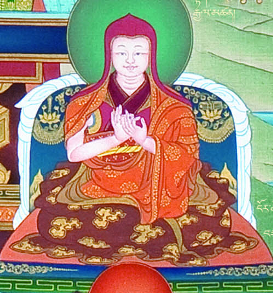Ngor Monastery: Difference between revisions
No edit summary |
No edit summary |
||
| Line 2: | Line 2: | ||
'''Ngor Ewam Chöden Monastery''' (ངོར་ཨེ་ཝཾ་ཆོས་ལྡན་, Wyl. ''ngor e waM chos ldan'') — an important [[Sakya]] monastery, and seat of the [[Ngor]] subschool, established by [[Ngorchen Kunga Zangpo]] around 1430. The monastery was named Ngor Ewam Chöden because during construction Ngorchen Kunga Zangpo dreamt that the whole collection of dharma arises from the letters E (་ཨེ) and WAM (་ཝཾ་). Before being completely demolished during the Chinese invasion, it was a very active monastery, counting about 1,000 monks in the 1950s. It has only been partly reconstructed. | '''Ngor Ewam Chöden Monastery''' (ངོར་ཨེ་ཝཾ་ཆོས་ལྡན་, Wyl. ''ngor e waM chos ldan'') — an important [[Sakya]] monastery, and seat of the [[Ngor]] subschool, established by [[Ngorchen Kunga Zangpo]] around 1430. The monastery was named Ngor Ewam Chöden because during construction Ngorchen Kunga Zangpo dreamt that the whole collection of dharma arises from the letters E (་ཨེ) and WAM (་ཝཾ་). Before being completely demolished during the Chinese invasion, it was a very active monastery, counting about 1,000 monks in the 1950s. It has only been partly reconstructed. | ||
Ngor Monastery is divided into four monastic houses (Tib. བླ་བྲང་, ''[[labrang]]''; Wyl. ''bla brang''): | Ngor Monastery is divided into four monastic houses that traditionally share the abbotship responsibilities and collectively lead the monastery's administrative and spiritual activities (Tib. བླ་བྲང་, ''[[labrang]]''; Wyl. ''bla brang''): | ||
*Luding (ཀླུ་སྡིངས་, ''klu sdings''), | *Luding (ཀླུ་སྡིངས་, ''klu sdings''), | ||
*Khangsar (ཁང་གསར་, ''khang gsar''), | *Khangsar (ཁང་གསར་, ''khang gsar''), | ||
Revision as of 19:37, 30 May 2019

Ngor Ewam Chöden Monastery (ངོར་ཨེ་ཝཾ་ཆོས་ལྡན་, Wyl. ngor e waM chos ldan) — an important Sakya monastery, and seat of the Ngor subschool, established by Ngorchen Kunga Zangpo around 1430. The monastery was named Ngor Ewam Chöden because during construction Ngorchen Kunga Zangpo dreamt that the whole collection of dharma arises from the letters E (་ཨེ) and WAM (་ཝཾ་). Before being completely demolished during the Chinese invasion, it was a very active monastery, counting about 1,000 monks in the 1950s. It has only been partly reconstructed.
Ngor Monastery is divided into four monastic houses that traditionally share the abbotship responsibilities and collectively lead the monastery's administrative and spiritual activities (Tib. བླ་བྲང་, labrang; Wyl. bla brang):
- Luding (ཀླུ་སྡིངས་, klu sdings),
- Khangsar (ཁང་གསར་, khang gsar),
- Thartse (ཐར་རྩེ་, thar rtse) and
- Phende (ཕན་བདེ, phan bde)
Ngor Monastery in Exile
- Ngor Monastery was re-established in Manduwala, India.
Further Reading
- Ronald Davidson, The Ngor-pa Tradition in Wind Horse, vol. 1, 1981, pp.79-98
- David Jackson, Sources on the Chronology and Succession of the Abbots of Ngor E-waṃ-chos-ldan, Berliner Indologische Studien. Band 4/5: 49-93, 1989.
- David P. Jackson, The 'Bhutan Abbot' of Ngor: Stubborn Idealist with a Grudge against Shugs-ldan in Lungta 14, 2001